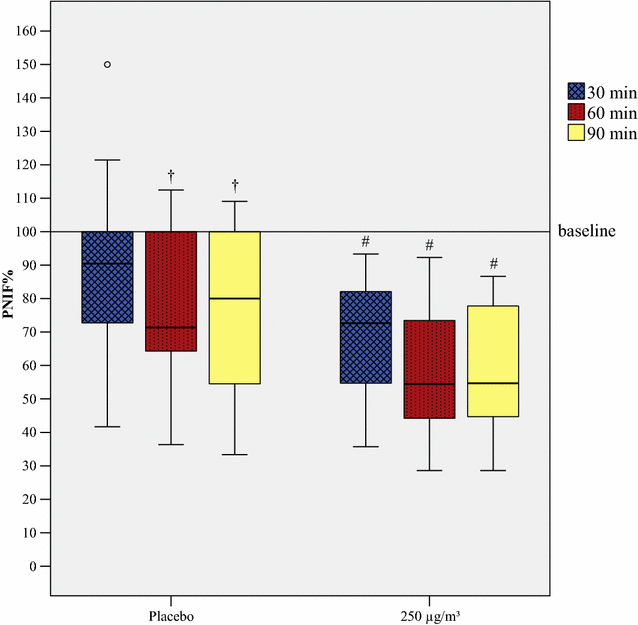Peak nasal inspiratory flow as outcome for provocation studies in allergen exposure chambers: a GA2LEN study
- PMID: 28932387
- PMCID: PMC5604509
- DOI: 10.1186/s13601-017-0169-4
Peak nasal inspiratory flow as outcome for provocation studies in allergen exposure chambers: a GA2LEN study
Abstract
Background: The GA2LEN chamber has been developed as a novel mobile allergen exposure chamber (AEC) allowing standardized multicenter trials in allergy. Hitherto, subjective nasal symptom scores have been the most often used outcome parameter, but in standardized modern trials objective parameters are preferred. Despite its practicability, the objective parameter peak nasal inspiratory flow (PNIF) has been rarely used for allergy trials in the setting of allergen exposure chambers. This study aims to evaluate PNIF as an outcome parameter for provocation studies in AECs.
Methods: In a randomized controlled blinded setting subjects suffering from allergic rhinitis were exposed to grass pollen, birch pollen, house dust mite and/or placebo in the GA2LEN chamber. Different allergen concentrations were used to evaluate symptom severities. Patients had to perform PNIF before and every 30 min during a challenge using a portable PNIF meter.
Results: 86 subjects participated in 203 challenges, altogether. House dust mite provocations caused the greatest reduction in PNIF values, followed by grass pollen and birch pollen. Provocations with every allergen or pollen concentration led to a significant decrease (p < 0.05) in PNIF compared to baseline. Furthermore, positive correlations were obtained between PNIF and peak expiratory flow, height and weight, and inverse correlations between PNIF and total nasal symptom score, nasal congestion score and visual analog scale of overall subjective symptoms.
Conclusion: PNIF is a helpful and feasible tool for conducting provocation trials with allergens, especially grass pollen and house dust mite, in an AEC.
Keywords: Allergen exposure chamber (AEC); Allergy trial; GA2LEN chamber; Peak nasal inspiratory flow (PNIF); Provocation study.
Figures




Similar articles
-
Comparative Evaluation of an Allergen Exposure Chamber and Nasal Allergen Challenge Versus In-Field Symptom Assessment in Patients With Allergic Rhinitis Triggered by Timothy Grass Pollen.Allergy. 2025 May;80(5):1286-1297. doi: 10.1111/all.16518. Epub 2025 Mar 9. Allergy. 2025. PMID: 40059339 Free PMC article.
-
First evaluation of a symbiotic food supplement in an allergen exposure chamber in birch pollen allergic patients.World Allergy Organ J. 2020 Dec 18;14(1):100494. doi: 10.1016/j.waojou.2020.100494. eCollection 2021 Jan. World Allergy Organ J. 2020. PMID: 33376575 Free PMC article.
-
Clinical validation of grass pollen exposure chamber in patients with allergic rhinitis triggered by timothy grass.Clin Exp Allergy. 2024 Jul;54(7):489-499. doi: 10.1111/cea.14482. Epub 2024 Apr 14. Clin Exp Allergy. 2024. PMID: 38616622
-
Clinical trial design, nasal allergen challenge models, and considerations of relevance to pediatrics, nasal polyposis, and different classes of medication.J Allergy Clin Immunol. 2005 Mar;115(3 Suppl 1):S460-82. doi: 10.1016/j.jaci.2004.12.016. J Allergy Clin Immunol. 2005. PMID: 15746883 Review.
-
[Rhinitis in adults].Acta Med Croatica. 2011;65(2):181-7. Acta Med Croatica. 2011. PMID: 22359885 Review. Croatian.
Cited by
-
Korean Modification of the Nasal Provocation Test With House Dust Mite Antigen Following the EAACI Guidelines.Clin Exp Otorhinolaryngol. 2021 Nov;14(4):382-389. doi: 10.21053/ceo.2020.00563. Epub 2020 Jul 7. Clin Exp Otorhinolaryngol. 2021. PMID: 32631039 Free PMC article.
-
Validity of Skin Prick Test to Bermuda Grass in a desert environment.Acta Biomed. 2021 Sep 2;92(4):e2021218. doi: 10.23750/abm.v92i4.11461. Acta Biomed. 2021. PMID: 34487076 Free PMC article.
-
Precision Medicine in Mite Allergic Rhinitis.Front Allergy. 2021 Sep 27;2:724727. doi: 10.3389/falgy.2021.724727. eCollection 2021. Front Allergy. 2021. PMID: 35387006 Free PMC article. Review.
-
Objectification of the nasal patency assessment techniques used in nasal allergen provocation testing.Postepy Dermatol Alergol. 2020 Oct;37(5):635-640. doi: 10.5114/ada.2019.81404. Epub 2019 Jan 21. Postepy Dermatol Alergol. 2020. PMID: 33240000 Free PMC article. Review.
-
Adherence to Prescribed E-Diary Recording by Patients With Seasonal Allergic Rhinitis: Observational Study.J Med Internet Res. 2020 Mar 16;22(3):e16642. doi: 10.2196/16642. J Med Internet Res. 2020. PMID: 32175909 Free PMC article.
References
-
- Pefura-Yone EW, Kengne AP, Balkissou AD, Boulleys-Nana JR, Efe-de-Melingui NR, Ndjeutcheu-Moualeu PI, Mbele-Onana CL, Kenmegne-Noumsi EC, Kolontchang-Yomi BL, Theubo-Kamgang BJ, et al. Prevalence of asthma and allergic rhinitis among adults in Yaounde, Cameroon. PLoS ONE. 2015;10:e0123099. doi: 10.1371/journal.pone.0123099. - DOI - PMC - PubMed
-
- Salo PM, Arbes SJ, Jaramillo R, Calatroni A, Weir CH, Sever ML, Hoppin JA, Rose KM, Liu AH, Gergen PJ, et al. Prevalence of allergic sensitization in the United States: results from the National Health and Nutrition Examination Survey (NHANES) 2005–2006. J Allergy Clin Immunol. 2014;134:350–359. doi: 10.1016/j.jaci.2013.12.1071. - DOI - PMC - PubMed
LinkOut - more resources
Full Text Sources
Other Literature Sources
Medical

